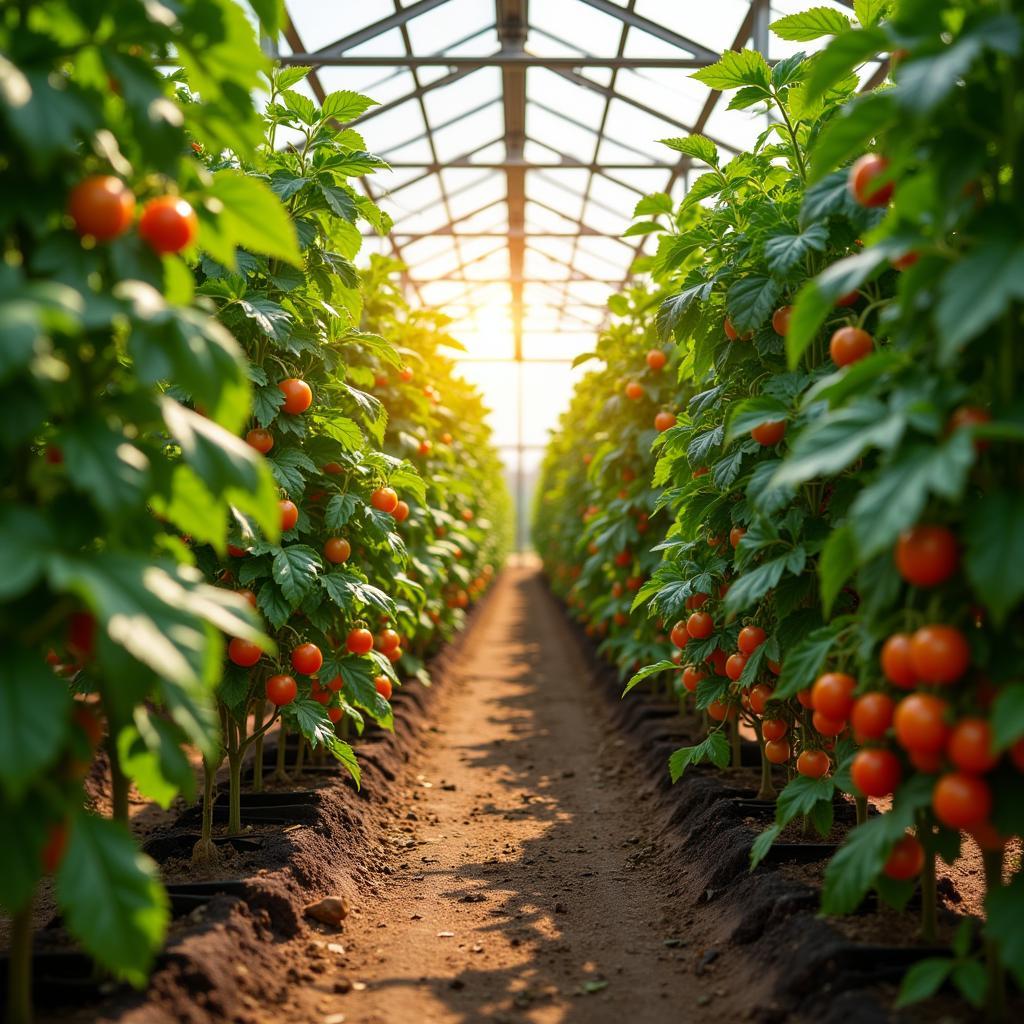Greenhouses for food production are revolutionizing how we cultivate crops, offering a controlled environment that optimizes growing conditions and extends the growing season. From leafy greens to juicy tomatoes, these structures are changing the face of agriculture and bringing fresh produce to our tables year-round. But what exactly are the benefits and challenges of this innovative approach? Let’s explore the world of greenhouse food production.
Looking for ways to reduce your food’s environmental impact? Check out biodegradable packaging for food.
Understanding the Benefits of Greenhouses for Food
Greenhouses provide a protective shield against harsh weather conditions, pests, and diseases, leading to higher yields and reduced crop losses. This controlled environment also allows for precise management of temperature, humidity, and light, creating optimal growing conditions for a wide variety of crops. This means farmers can grow crops out of season, extending the availability of fresh produce and reducing reliance on imports. Furthermore, greenhouse cultivation can be more water-efficient than traditional farming methods, as water can be recycled and delivered directly to the plants’ roots.
 Greenhouse Tomato Cultivation: Optimal Growing Conditions for High Yields
Greenhouse Tomato Cultivation: Optimal Growing Conditions for High Yields
Exploring Different Types of Greenhouses for Food
There are several types of greenhouses, each designed for specific purposes and climates. Hoop houses are simple, inexpensive structures ideal for extending the growing season or protecting young plants. Gothic arch greenhouses offer more space and are suitable for larger-scale operations. Geodesic dome greenhouses are known for their strength and energy efficiency. The choice of greenhouse depends on factors such as the type of crops being grown, the climate, and the budget.
Want to explore the future of food? Learn more about Future Food Tech SF.
The Role of Technology in Modern Greenhouses
Technology plays a crucial role in maximizing efficiency and productivity in modern greenhouses. Automated irrigation systems deliver precise amounts of water to each plant, minimizing water waste. Climate control systems regulate temperature and humidity, creating the ideal growing environment. Sensors monitor light levels, soil moisture, and nutrient levels, providing real-time data that helps farmers make informed decisions. These advancements are transforming greenhouse farming into a highly sophisticated and data-driven operation.
Addressing the Challenges of Greenhouse Food Production
While greenhouses offer numerous advantages, they also present certain challenges. The initial investment cost can be substantial, especially for larger, technologically advanced structures. Energy consumption can also be a concern, particularly in colder climates. Furthermore, managing pests and diseases within a closed environment requires careful monitoring and integrated pest management strategies. However, ongoing research and development are constantly seeking innovative solutions to these challenges.
Did you know that some foods are more sustainable than others? Read more about ev00 food.
What is the Future of Greenhouse Food Production?
The future of greenhouse food production is bright, with ongoing advancements in technology and sustainable practices. Vertical farming, a method of growing crops in stacked layers within a controlled environment, is gaining traction as a space-saving and resource-efficient approach. Hydroponics and aquaponics, which involve growing plants without soil, offer further opportunities for sustainable food production in greenhouses. These innovations are paving the way for a more resilient and sustainable food system.
Is your food packaging eco-friendly? Learn about sustainable pet food packaging.
Conclusion: Embracing the Potential of Greenhouses for Food
Greenhouses for food production offer a promising solution to the challenges of feeding a growing population while minimizing environmental impact. By providing a controlled environment, optimizing resource use, and extending the growing season, greenhouses are playing a vital role in shaping the future of agriculture. As technology continues to advance and sustainable practices become increasingly important, greenhouses will undoubtedly become an even more integral part of our food system. So, embrace the potential of greenhouses, and let’s cultivate a more sustainable and food-secure future together.
FAQ
-
What are the main advantages of using greenhouses for food production? Greenhouses protect crops from harsh weather, pests, and diseases, leading to higher yields and extended growing seasons.
-
What types of crops can be grown in a greenhouse? A wide variety of crops, from vegetables and fruits to herbs and flowers, can be grown in greenhouses.
-
Are greenhouses environmentally friendly? Greenhouses can be more water-efficient than traditional farming and reduce the need for pesticides, but energy consumption can be a concern.
-
What is the cost of setting up a greenhouse? The cost varies depending on the size, type, and technology used, ranging from simple hoop houses to sophisticated, climate-controlled structures.
-
How can technology improve greenhouse food production? Automated systems for irrigation, climate control, and monitoring can optimize resource use and increase efficiency.
-
Is food littering a problem? Yes, it contributes to environmental pollution and attracts pests.
-
What’s the difference between hydroponics and aquaponics? Hydroponics grows plants without soil using nutrient-rich water, while aquaponics integrates fish farming to provide natural fertilizer for the plants.
Common Greenhouse Scenarios & Questions:
Scenario: Pests are damaging my greenhouse crops. Question: What are some effective pest control methods for greenhouses?
Scenario: My greenhouse plants aren’t growing as expected. Question: What are the optimal temperature and humidity levels for my specific crops?
Scenario: I’m considering building a greenhouse. Question: Which type of greenhouse is best suited for my climate and budget?
Further Exploration:
Explore related articles on our website for more information on sustainable food practices, such as “EV00 Food” and “Biodegradable Packaging for Food”.
Contact Us:
For further assistance, please contact us at Phone Number: 02437655121, Email: [email protected], or visit us at 3PGH+8R9, ĐT70A, thôn Trung, Bắc Từ Liêm, Hà Nội, Việt Nam. Our customer service team is available 24/7.